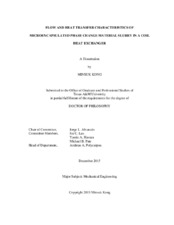| dc.description.abstract | The use of enhanced heat transfer fluid and heat exchanger can improve the performance of thermal energy systems. Microencapsulated phase change material (MPCM) slurry is considered as an enhanced heat transfer fluid and can be used in heat transfer applications because of the higher heat capacity of MPCM slurry, which can improve heat transfer performance. In addition, coil heat exchangers (CHX) have been used in various heat transfer applications due to their compact structure and superior heat transfer performance. However, little is known about how MPCM may exhibit enhanced heat transfer performance in CHX. Therefore, flow and heat transfer characteristics of MPCM slurry in CHX have been investigated.
Fully instrumented pressure drop and heat transfer test sections were built to investigate pressure drop and the local convective heat transfer characteristics of MPCM slurry in a coiled tube, which resembles a CHX. The thermophysical properties of MPCM slurry were measured and characterized experimentally. The viscosity results show that MPCM slurry with a mass fraction of 10.9 % or less can be considered as a Newtonian fluid. Pressure drop and heat transfer experiments were conducted at different mass fractions of MPCM slurries under turbulent flow conditions. The pressure drop results indicate that higher viscosity of MPCM slurry increases pressure drop, which is greater than water. Furthermore, the correlated friction factor curve of MPCM slurry compares well with previous correlations used for homogeneous Newtonian fluids. The heat transfer results indicate that phase change process of the PCM enhances the heat transfer coefficient of MPCM slurry. However, the heat transfer coefficient of MPCM slurry still is lower than that of water due to decreased momentum transfer. The experimental results also show that secondary flows are imminent and lead to variations in heat transfer coefficient within the coiled tube. Useful correlations have been postulated to predict friction factor and Nusselt number of MPCM slurry in a coiled tube, respectively. Energy evaluation analyses were conducted to determine the benefits of using MPCM slurry in terms of heat transfer performance and heat capacity, respectively. The results show that MPCM slurry cannot enhance the heat transfer performance due to the high viscosity and low latent heat of fusion of the PCM, but it can considerably improve the heat capacity. | en |


